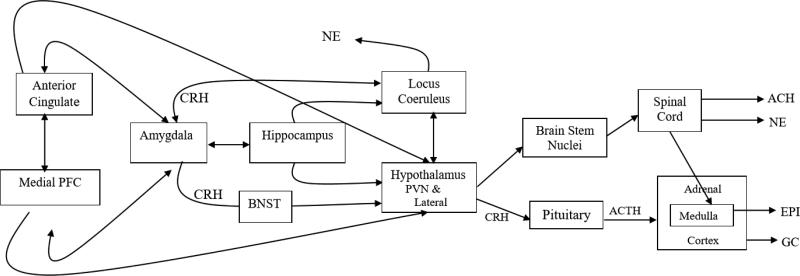Figure 1.
The anterior cingulate cortex (ACC) and the medial prefrontal cortex (mPFC) relay information to subcortical structures involved in the stress response. There are regions of the ACC and mPFC that activate and others that inhibit stress responding, in part through reciprocal connections with the amygdala. Both the hippocampus and the amygdala also maintain connections to the locus coeruleus (LC) which releases NE to brain areas involved in alerting. The ACC, mPFC, and amygdala, as well as the hippocampus, all have inputs into the hypothalamus, although these inputs are multisynaptic. Nuclei in the lateral hypothalamus activate highly interconnected nuclei in the brainstem, including the parabrachial nuclei, that regulate the sympathetic (norepinephrine, NE and Epinephrine, Epi) and parasympathetic (acetylcholine, Ach) nervous systems via pathways traveling through the spinal cord to preganglionic nuclei or to target organs (e.g. the adrenal medulla). In the paraventricular region of the hypothalamus, corticotropin-releasing hormone is produced; it then travelsthrough the hypophysial portal system to the anterior pituitary gland and stimulates the production and release of adrenocorticotropic hormone (ACTH). ACTH stimulates cells in the adrenal cortex to produce glucocorticoids (cortisol in humans). There are complex feedback loops from the periphery to the CNS that help to regulate the stress system. (Reprinted with Permission from Gunnar & Davis, 2003).

